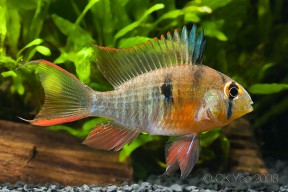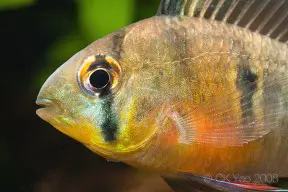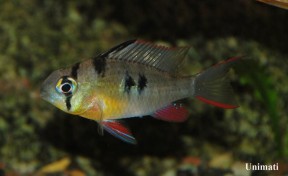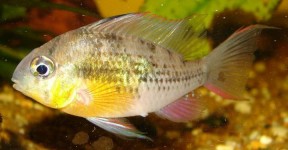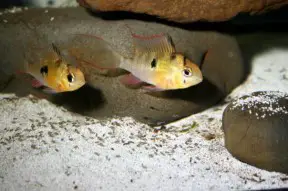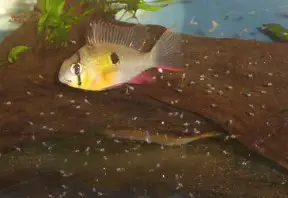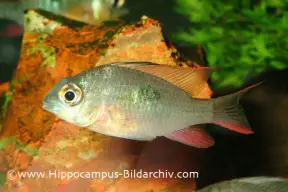Mikrogeophagus altispinosus
Bolivian Ram
SynonymsTop ↑
Crenicara altispinosa Haseman, 1911; Microgeophagus altispinosus (Haseman, 1911); Papiliochromis altispinosus (Haseman, 1911)
Etymology
Mikrogeophagus: from the Greek μικρός (mikrós), meaning ‘small’, and the generic name Geophagus.
altispinosus: presumably from the Latin altus, meaning ‘high’, and spinosus, meaning ‘thorny, prickly’.
Classification
Order: Perciformes Family: Cichlidae
Distribution
This species is considered endemic to the upper rio Madeira basin in Bolivia and Brazil.
Records exist from the Río Mamoré and Río Guaporé drainages in Bolivia (where the Guaporé is known as the Iténez) and Brazil plus the upper Río Orthon (ríos Tahuamanu and Manuripi).
Type locality is ‘sand-bank in the Rio Marmoré, below the mouth of the Rio Guaporé’ with some of the type series also ‘taken in a large lake near San Joaquin, Bolivia’.
Habitat
Little information is available but presumably inhabits tributaries, marginal zones, oxbows and lakes with substrates of sand or mud.
The upper Madeira system is spectacularly diverse with more than 400 freshwater fish species reported to date.
Some of those known in the aquarium hobby include Aphyocharax alburnus, Gymnocorymbus ternetzi, Hemigrammus lunatus, H. ocellifer, Hyphessobrycon agulha, H. bentosi, H. serpae, Moenkhausia colletti, Thayeria boehlkei, Tyttocharax tambopatensis, Carnegiella striata, Gasteropelecus sternicla, Nannostomus trifasciatus, Pyrrhulina australe, Brochis splendens, Corydoras acutus, C. hastatus, Rineloricaria spp., Pseudohemiodon spp., Apistogramma linkei, Biotodoma cupido, Geophagus megasema, Mesonauta festivus and Satanoperca jurupari.
Maximum Standard Length
70 – 80 mm.
Aquarium SizeTop ↑
This species should be maintained as a solitary individual, or a bonded pair. It may be housed in a group provided the aquarium is spacious; an aquarium with a base measuring at least 90 ∗ 45 cm or equivalent is recommended for an individual (in a community setting) or a pair.
Maintenance
The most essential addition is a soft, sandy substrate so that the fish can browse naturally (see ‘Diet’). Coarser options such as gravel or small pebbles can inhibit feeding, damage gill filaments and even be ingested with the potential of internal damage or blockages.
Other décor can consist of wood roots and branches placed such a way that plenty of shady spots and caves are formed, plus one or two flat rocks or similar to provide potential spawning sites.
Aquatic plants can also be used with those from genera such as Microsorum, Taxiphyllum, Cryptocoryne and Anubias perhaps most useful since they can be grown attached to the décor, although none of these are native to South America.
Filtration, or at least water flow, should not be excessive and very large water changes are best avoided with regular changes of 10-15% recommended.
This species should never be added to new or otherwise biologically immature aquaria. When conditions deteriorate it becomes susceptible to a condition similar to that referred to as head and lateral line erosion or hole-in the-head in other species which initially manifests itself as small pits formed by eroding flesh around the head and lateral line pores.
Water Conditions
Temperature: 24 – 28 °C
pH: 6.0 – 7.5
Hardness: 18 – 179 ppm
Diet
Mikrogeophagus spp. are benthophagous by nature, normally taking mouthfuls of substrate which are sifted for edible items with the remaining material expelled via the gill openings and mouth, although they will also browse solid surfaces and snatch items directly from the water column.
In the aquarium they should be offered a variety of live and frozen fare such as bloodworm, Artemia, Daphnia, grindal worm, etc. supplemented by good quality, sinking dried foods of a suitably small size. Wild fish may initially refuse the latter but normally learn to accept them over time.
Home-made, gelatine-bound recipes containing a mixture of dried fish food, puréed shellfish, fresh fruit and vegetables, for example, also work well and can be cut into bite-sized discs using the end of a sharp pipette or small knife.
Behaviour and CompatibilityTop ↑
Despite normally being sold as such M. altispinosus is not recommended for the general community aquarium since it requires pristine water quality and is a poor competitor, although that is not to say it must be maintained alone.
Groups of peaceful, open water-dwelling characids or similar are particularly recommended tankmates since the presence of small schooling or shoaling fishes appear to be considered an indicator that there is no immediate threat in the vicinity and therefore can help reduce shyness.
Peaceful bottom-dwellers such as Corydoras spp. catfishes can also be included and many smaller loricariids are also suitable.
Be sure to research your potential choices in depth and avoid territorial or otherwise aggressive fishes, including most other cichlids, and those requiring harder water.
M. altispinosus is a relatively gregarious cichlid and should ideally be maintained in a mixed-sex group of 6-8 or more provided the aquarium is spacious (120 cm length or larger). In confined space, the males frequently become more aggressive in defending their respective territory. This species was first imported by Horst Linke and Wolfgang Staeck in 1985, and their reported habitat observations suggest that this species appears to live in solitude (individual fish alone) apart from reproduction periods (Linke & Staeck, 1994).
Sexual Dimorphism
Adult males grow larger than females, possess slightly more-extended fins and are more intensely-coloured.
Reproduction
This species is a biparental substrate spawner and is best bred in a dedicated set-up with no other fishes present.
There does not appear to be any particular trigger for the spawning process with the main requirements being good diet and stringent maintenance regime. Unless sexable adults are available it is best to begin with a group of young fish and allow pairs to form naturally.
The eggs are normally laid on a solid surface such as a flat rock, piece of driftwood, broad plant leaf or directly on the aquarium glass, and spawning occurs in typical style with the female laying one or more rows of eggs before the male moves in to fertilise them, this process being repeated numerous times.
Inexperienced pairs may initially eat their brood but often get things right after a few attempts.
If maintaining the adults in a community situation it is recommended to remove either tankmates or eggs should you wish to raise good numbers of fry. Both male and female participate equally in brood care.
Incubation is 2-3 days after which the fry remain largely immobile for a further 5-8 days during which period they do not require any supplementary food.
If left with the parents they will be moved to a pre-excavated depression or ‘pit’ in the substrate once hatched, and are often moved between several such pits on a daily basis.
Once free-swimming microworm, Artemia nauplii, and suchlike can be introduced.
NotesTop ↑
This species is also traded as ‘hi-fin ram’ ‘Bolivian butterfly’ or ‘ruby crown cichlid’ and is arguably a better choice for less-experienced aquarists than its congener M. ramirezi.
The genus Mikrogeophagus currently contains just two recognised species. They are separated from one another in a geographical sense with M. ramirezi occurring in Venezuela and Colombia and M. altispinosa native to Bolivia and western Brazil. The latter is also a larger, less-colourful fish lacking blue iridescent markings on the fins, body and head.
The grouping has a confused taxonomic history with the correct placement and spelling of type species M. ramirezi a source of confusion for several decades prior to the publication of Kullander (2011). It was described as a member of the genus Apistogramma but later affiliated with the name Microgeophagus in an aquarium book by Hans Frey (1957) who did not provide diagnostic characters and only suggested it might be placed into that genus in the future.
The latter name did not achieve general acceptance until 1971 when Axelrod used it in a popular book about breeding aquarium fishes, although Klee (1971) rejected this and suggested that the species should instead be included in Geophagus. Kullander (1977) described the new genus Papiliochromis with P. ramirezi as type species, and in the same paper considered Microgeophagus to be an unavailable name without providing precise detail as to why.
Papiliochromis was accepted in both hobbyist and scientific literature until Bailey and Robins (1982) concluded that Microgeophagus sensu Axelrod (1971) was the oldest available name for a cichlid genus with A. ramirezi as type species, and thus should be considered valid.
Géry (1983, 1986) argued that Microgeophagus sensu Frey (1957) is the oldest available name for the genus, while Allgayer (1985) considered Papiliochromis valid. Kullander (1998) used Mikrogeophagus, a name he considered the oldest available based on its inclusion as a valid name in Jeg har akvarium, a Danish language aquarium book published in 1968, with Microgeophagus sensu Frey (1957) an unavailable nomen nudum lacking both a diagnosis and type species.
The genus Mikrogeophagus is thus attributed to Jens Meulengracht-Madsen, 1968, who authored the relevant sections in the book (it was edited by Schiøtz and Christensen), but it is considered an ‘involuntary’ nomenclatural act because the author believed he was using an existing name.
Mikrogeophagus therefore became widely-accepted following Kullander (1998), although a number of authors evidently did not agree.
After a period of inactivity Isbrücker (2011) re-opened the issue and argued that Microgeophagus sensu Frey (1957) is actually the oldest available name for the genus, but this was definitively rejected by Kullander (2011) who published a detailed analysis of the different generic names that have been used for the species, the majority of which were derived from aquarium, rather than scientific, literature.
Although Mikrogeophagus is now generally accepted to be correct the species M. ramirezi commonly appears in older aquarium literature as Apistogramma ramirezi, Microgeophagus ramirezi, or Papiliochromis ramirezi.
Mikrogeophagus and a number of related genera are often included in the putative subfamily Geophaginae.
Kullander (1998) conducted a morphology-based phylogenetic study in which the neotropical Cichlidae was divided into six subfamilies of which the Geophaginae contained 16 genera divided among three ‘tribes’:
Acarichthyini – Acarichthys and Guianacara.
Crenicaratini – Biotoecus, Crenicara, Dicrossus and Mazarunia.
Geophagini – Geophagus, Mikrogeophagus, ‘Geophagus‘ brasiliensis group, ‘Geophagus‘ steindachneri group, Gymnogeophagus, Satanoperca, Biotodoma, Apistogramma, Apistogrammoides and Taeniacara.
Later molecular studies by Farias et al. (1999, 2000, 2001) resulted in the additions of Crenicichla and Teleocichla to the Geophaginae, a result supported by López-Fernández et al. (2005) who conducted the most detailed molecular analysis of the grouping to date including 16 of the 18 genera and 30 species.
However their conclusions regarding interrelationships between genera did vary somewhat from previous hypotheses and can be summarised by the following loosely-defined groups:
– a weakly-supported sister group relationship between Acarichthys and Guianacara.
– a well-supported ‘Satanoperca clade’ comprising Satanoperca, Apistogramma, Apistogrammoides and Taeniacara.
– a ‘big clade’ with Geophagus, Mikrogeophagus, ‘Geophagus‘ brasiliensis group, ‘Geophagus‘ steindachneri group, Gymnogeophagus, Biotodoma, Crenicara and Dicrossus.
– a ‘crenicarine clade’ with Biotoecus and Crenicichla.
No representatives of Teleocichla or Mazarunia were included in the study but the former is well-established as sisterto Crenicichla while the latter has grouped closely with Dicrossus and Crenicara in earlier works.
The other main conclusions of the paper are confirmation that Geophaginae is a monophyletic group exhibiting strong signs of having undergone rapid adaptive radiation (diversification of a species or single ancestral type into several forms that are each adaptively specialised to a specific environmental niche).
References
- Haseman, J. D., 1911 - Annals of the Carnegie Museum v. 7 (nos 3-4) (18): 329-373
An annotated catalog of the cichlid fishes collected by the expedition of the Carnegie Museum to central South America, 1907-10. - Chernoff, B., A. Machado-Allison, P. Willink, J. Sarmiento, S. Barrera, N. Menezes and H. Ortega, 2000 - Interciencia 25(6): 273-283
Fishes of three Bolivian rivers: diversity, distribution and conservation. - Kullander, S. O., 2011 - Zootaxa 3131: 35-51
Nomenclatural availability of putative scientific generic names applied to the South American cichlid fish Apistogramma ramirezi Myers & Harry, 1948 (Teleostei: Cichlidae). - Linke, Horst and Wolfgang Staeck, 1994 - Tetra - Press
American Cichlids I, Dwarf Cichlids - Morgenstern, R., 2012 - DCG-Informationen 43(4): 74-82
Microgeophagus, Papiliochromis oder Mikrogeophagus – endlich Klarheit? - Reis, R. E., S. O. Kullander and C. J. Ferraris, Jr. (eds), 2003 - EDIPUCRS, Porto Alegre: i-xi + 1-729
Check list of the freshwater fishes of South and Central America. CLOFFSCA. - Robins, C. R. and R. M. Bailey, 1982 - Copeia 1982(1): 208-210
The status of the generic names Microgeophagus, Pseudoapistogramma, Pseudogeophagus and Papiliochromis (Pisces: Cichlidae).
